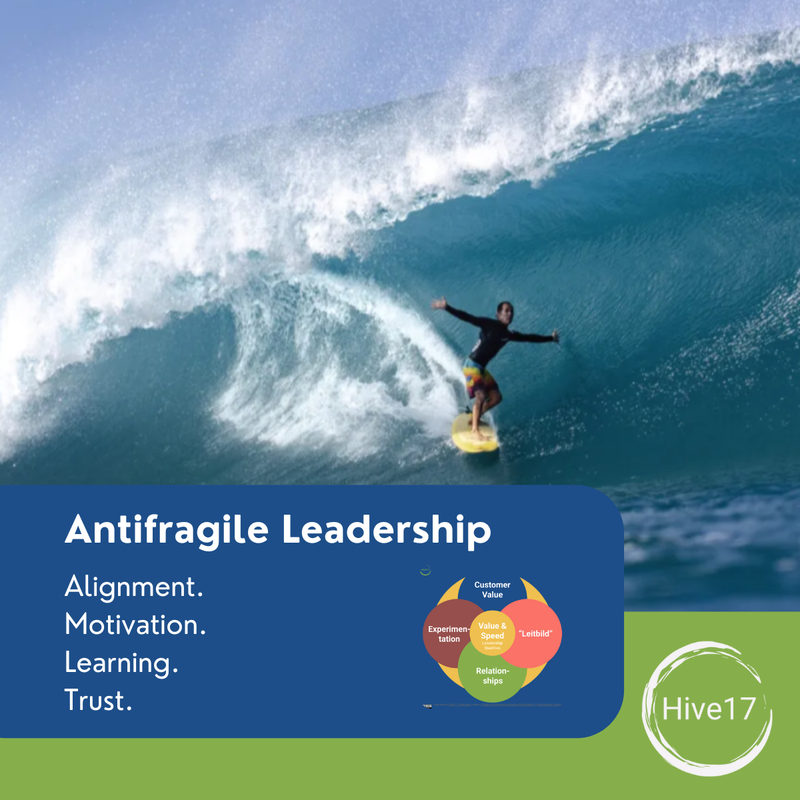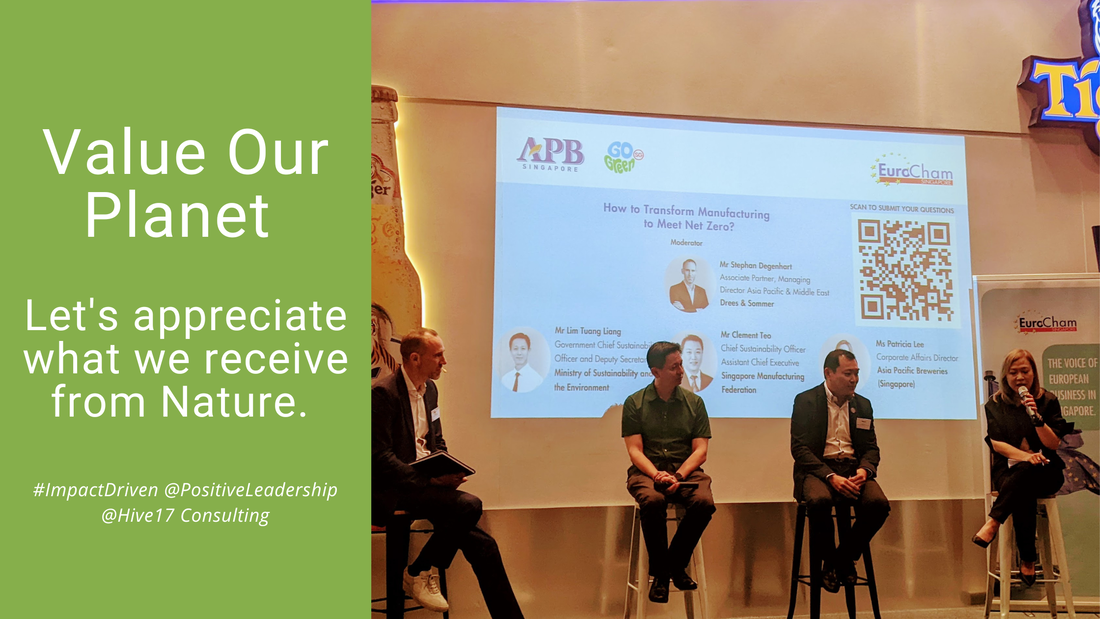0 Comments
Frustrated that people don't follow your lead? Find out where your leadership style is fragile30/4/2024
I want to express my heartfelt appreciation for initiating this [leadership] training program.
How are you making sure your organisation is dedicated to the same direction, stays strongly engaged to move forward and your teams are striving to give their best? Great leadership is without doubt the (not so) secret recipe to lasting success. It creates the resilience to go through uncertain times and enables the necessary transformations.
What do you need to lookout for in 20204? Swiss leadership institute IMD shared earlier this month how they predict the trends for this year. Let me share them here with you.
How will you drive change in your organisation? Source: Seven leadership trends to focus on in 2024 This year might become a tough year and there might not be much we can do about it - especially about the external and geopolitical aspects. What we can focus on as a leader is to equip the organisation and enable our teams to give their best. And one special aspect is Energy!
Organisational Energy is what I want to talk about today. How often do we feel that work is draining our energy? That the efforts within an organisation are clashing; that people are lethargic and inert. And as a leader we simply wish that we are able to give our teams a spark. I recently came across the work of Heike Bruch and it is refreshing to see peers that are sharing the same vision and passion for energy, positivity, and enabling Drive within our work ecosystem. Here are some of her thoughts on the topic:
As with many things with effective teams, the collective energy is larger then the sum of the individuals. When we align this energy we can create synergy that triples or tenfolds the efforts. As a team we can then ride that wave and easily overcome barriers. We can collectively become antifragile. Source: TEDxZurich - Heike Bruch on How to Manage Organizational Energy A New Year has started and fresh inspirations are coming in. At Hive17 we focus on facilitating effective teams, and that is particularly important on the top (also check our recent CxO Team post). Just yesterday, the Embassy of Switzerland in Singapore shared a post about the Swiss Federal Presidency and the Swiss Federal Council. An example I like to share as it is a high-level model for a self-organising team.
CxO Teams are in similar situations; they have broad and deep responsibilities; they have the tendency to focus the majority of their time on their own department; they tend to work less as one team. The Swiss government puts a structure in place to counter these tendencies. A structure that any company can learn from and become more effective in delivering change. Here are some suggestions to look out for:
How do you build a more effective and self-organised CxO team? Source: Swiss Federal Presidency, LinkedIn The end of the year is coming and I got asked, if you would give one piece of advise, what would it be? In my experience dealing with leaderships, one foundational attitude I discovered is Win-Win. In our work life we come across various situations: developing a product, negotiate with a client, hire an employee, resolve conflict, onboard a supplier, provide feedback, conduct meetings, and simply solve a problem. When you observe yourself in these situations, how often do you want to win, how often do you want the other party to lose? Or you might simply not care if you lose. All these attitudes have in common that they are not effective. For success, we need to practice a win-win attitude. When I help people to obtain this new approach, I usually share Green & Clean by Stephen Covey - a fun and inspiring introduction to the topic. And there are so many great quotes which I would like to share here:
How will you approach win-win in your next negotiation? “Only 41% of CEOs believe employees’ behaviours are mostly aligned with company’s values and direction.” This statement from PwC's annual CEO survey means that about 60% of the employees are not fully aligning their productivity with the company's priorities. As a result, efforts are wasted in the wrong direction. Further, according to Hive17's surveys, about a third of the managers underestimate the importance of goal setting for motivation.
How are you going about setting targets for 2024 to create maximum impact for your business? Hive17 successfully implemented vision to action programs since over six years, driving change for new strategies and large-scale initiatives. At it's core is a interactive approach that translates your strategy into actions in people's daily work. What we deliver is:
Our programs focus on principles, structures, tools and behaviours to enable everyone in the entire organisation to give their best. How do you plan to create more impact for 2024? Source: Leading in the new reality, PwC's 26th Annual Global CEO Survey - Asia Pacific, January 2023 Enabling teams to give their best - When I approach CEOs with this topic, they almost always think this is important for the teams reporting to them. Yes, the operations team needs to work more effectively. That business unit needs a boost in productivity. In the organisation, the different functions need to work closer together across the silos. While these are important areas for improvement, we forget one important team.
What about that team on the top? The CxOs forming a team together with the CEO. How important is it that they are a highly effective team? In my experience, when this group of people are not enabled to give their best, it will slow down the entire organisation. Here are some of my observations:
What can we do as CEOs to build stronger bonds, create a solid team that is effective and is setting the right platform for a great company culture? Here are some simple steps:
Where do you see the barriers to effectiveness in your team? When will you schedule your next CxO lunch? "Hope is not enough: turning vision into climate action!" This was one of the themes of the second Green Tech Festival held in Singapore. And for concrete and lasting action, I believe we need two essential ingredients: innovation & culture. This was a theme that weaved throughout the presentations and panels at the conference.
One example that stood out for me was the Hot Heart - a project with the purpose of decarbonising the district heating system in the Finnish capital. One the one hand, the technical solution is innovative in a way that it integrates the energy storage component when harvesting renewable energy for keeping the citizens warm. On the other hand, the transformed the technocractic solution with an experience for its community: establishing a all-year tropical island right in front of the city gates. Why is this important? In this way you bring the technology closer to the people, allow them to interact and benefit from the solution - in a very direct way. This will accelerate acceptance and inspire new innovation. We at Hive17 believe that driving a sustainability culture in your organisation will drastically increase the adoption of climate action and in turn your efforts in substantial triple-bottom-line benefits. How will your start your internal movement? Learn more about The Hot Heart. Most companies are stuck in their corporate patterns: large overhead costs and bureaucratic burdens; a focus on short-term results; an inert workforce following a handful of leaders; exposure to bias and unfairness. We sort of know it is wrong, but we don't have the means to change to the better.
Except for one company! Very few people heard of the company Gore (mainly famous for its Gore-Tex fabrics) which churns out 3 billion USD of revenue with 9'000 employees worldwide. Gore has a very different management philosophy: no hierarchy, family feeling, CEO is selected via a poll, etc. The fundamental belief at Gore is that individuals know what's right for the company and success comes from collaboration in small teams; "we are all in the same boat". Followed by the guiding principles of freedom, fairness, commitment, transparency. On my side, I love to share the story of Gore in order to inspire and show, it is possible to lead differently. Enabling leaders to think out of the box and facilitate change. Here are a few of the elements that define the leadership innovation at Gore:
Reading through this story, I see Hive17's Human Operating System confirmed: we need to start with a shared direction; then creativity comes up with solutions; experimentation allows to polish these ideas; and solid relationships motivate and allow fast decision-making. How do you enable your teams to give their best? Source: Innovation Democracy: W.L. Gore's Original Management Model Photo Credit: Charlie Bibby, FT What are the two most important and sought after leadership skills in Asia? Based on the research of GloCoach, they identified the two following skills:
From our practice at Hive17 we can only underline the value of these two leadership skills in order to bring positive change within your organisation. And we observe that many leaders struggle to apply these skills on a consistent basis. How fragile are your leadership skills? How well do you understand the qualities to successfully lead a team? And, how confident are you to implement these leadership skills in your daily work? Here is the solution: Hive17's Antifragility Score is assessing your teams leadership qualities with a unique focus on teams and how to enable them to give their best. This assessment includes:
Accelerate the engagement in your team which leads to improved innovation, productivity and retention. Your individual antifragility score is for free! Every year, my Alma Mater brings about 70 students from St.Gallen to Singapore for an exchange semester - undoubtedly an unforgettable and important experience. As part of their program, they conduct a consulting project with their peers at SMU. Over the years, we observed one key ingredient for successful projects: effective collaboration within the teams.
This year I had the honour again to introduce how to form effective teams in a short period of time. I feel it is always so insightful and a great learning experience for me to work together with students. Absorbing their curiosity and insightful point of view. Here are the key steps we covered in the 90 minutes session. Start with a win-win attitude. When we are entering a meeting, negotiating or selling our products, how often do you observe that one party wants the opponent to lose out? We can only achieve maximum synergy if we consider the win of the other party and have the courage to stand for our win as well. Effective teamwork happens when we enable all team members to give their best. This requires clear, common goals, shared leadership, a desire to deliver high quality, quick decision-making, and a high level of energy. And let's not forget that the work environment strengthens the mutual trust. Shared values are the basis of team principles. These will provide guidance on how the team wants to work together and also establishes boundaries. The team principles also include ways how we get to know each other better and build social connections. Conflict will arise and effective teams are not good at avoiding conflict - they are good at conflict management. First step: deflate emotions. When we are super excited or very angry - in any case, we won't be able to think rationally and create solutions that resolve the conflict. What are your key ingredients for effective teams? This week we had another great Sustainability event in Singapore - organised by Lufthansa Group. While the airline industry overall is struggling to curb carbon emissions, it is great to see that one important player is striving forward on their sustainability journey. Maybe the most prominent technology is AeroShark - a nature-inspired film that is reducing the friction and drag of a plane's fuselage.
The event brought together industry experts into different panels that discussed sustainability also beyond the airline industry. For a while now, I have been pondering about key words that describe sustainability journeys. During this event, I have put more thought into these descriptors which guide us on a solid path towards a better planet and society. Honesty - past incidents of greenwashing have shown that solid reporting is essential in order to gather internal and external support for the ESG journey. We need to create more transparency and credibility, so that we can strengthen our reputation towards consumers, regulators and talents. Lufthansa has illustrated their effort and dedication to report on a long list of standards. Frugality - frugality means the careful use of resources and this is strongly related to reducing our consumption of energy, raw materials and natural landscapes. Operational efficiency is not only a driver to reduce cost, in most cases these solutions also have a net positive effect on the environment. The AeroShark film, better transport routing and switching to more efficient drive trains are some great examples. Courage - risk is a large driver in corporate decision making and often, this is holding back crucial investment decisions. Bold new strategies into an uncertain future requires courage - and we need environments that are enabling more risk taking. One great example was Jungheinrich where the board decided five years ago to fully embark on their sustainability journey; this courage has paid off very well for them. Synergy - sustainability journeys demand stronger collaboration between the silos within an organisation and beyond their company borders. This collaboration is facilitated with common goals and a belief that together we can achieve more. It was also highlighted that academia and industry need to work much closer and share insights. Together we are stronger. The journey towards a greener and fairer planet can be daunting. These four underlying principles can act as a guide towards more successful sustainability transformations. Which drivers do you suggest to add? When talking about sustainability, there are a few important terms that come to my mind: honesty, courage, frugality, etc. Today, I want to talk about courage.
The former Unilever CEO Paul Polman shared a number of insights in this interview and I want to highlight two quotes which are well linked together:
Basically, we need to shift our mindset to "win-win" - currently we are stuck in win-loose. This new attitude means the planet wins, our global community wins, and we as companies win. In order to achieve this, our operations and products need to become restorative, reparative and regenerative. This is what we as net positive leaders are required to do. What is the biggest barrier? It is not technology, finances or capabilities. The biggest barrier is courage. What are Paul's suggestions?
Yes, this sounds huge; it is huge. Still, the best time to make your first step in this direction is today. One step at the time. What is your first step? Source: Former Unilever CEO Paul Polman Says Aiming for Sustainability Isn’t Good Enough—The Goal Is Much Higher, Harvard Business Review, November 2019 Our current times are full of change and a solid strategy is necessary to give the organisation direction and alignment to create lasting success. Furthermore, a meaningful and clear vision is driving motivation and is a strong ingredient for making decisions. Yet, many companies struggle to bring their vision to the ground. Employees are saturated with changing strategies and often don't see how the new directions are impacting their daily work.
"Only 41% believe current employee behaviours are mostly aligned to company values and direction." - 26th Annual Global CEO Survey - Asia Pacific | PwC | January 2023 (link) Often, new strategies come with flashy posters, inspiring townhalls and a set of top-down KPIs. And then the rest of the organisation is left to create success. And in 59% of the cases, it doesn't happen. We need to go beyond that. How can we best engage to translate vision into action? In my experience, there are three key areas:
In the process of setting and propagating targets, it is also important that we provide the wider context and that this is a collaborative bottom-up process. Let the people define their own targets and how to review them. As a leader, your role is to provide guidance and support. At Hive17 Consulting, we have been running 'Vision to Action' workshops for over six years with great success. They are establishing an environment where target setting and reviews are building strong alignment, direction and motivation. This week the EuroCham has organised a great event about "How to Transform Manufacturing to Meet Net Zero?" with a very vivid and insightful panel. One highlight I want to share is the answer to the question: what would you wish if you had a magic wand?
"If I had a magic wand, I would bring people back to value our planet! Create that feeling of appreciation for what we are receiving from Earth. I wish that people would see the value they are getting out of nature. It is time to pay back." Very powerful words and I can only strongly support this wish. The event was linked with an introduction and visit of the production site of Asia Pacific Brewery, and the company is very strong with their impact related activities. The organisation is passionate about their 'brewing a better world' campaign and clearly working along the triple bottom line of planet-people-profits. Let's continue to strengthen the awareness that sustainability is a huge business opportunity. We as individuals, as organisations and as societies can greatly benefit. We just finished a team retreat and during the closing, the client shared "this was amazing, we never got the people to share so much. The sessions were fun, insightful and engaging. Thank you so much!". How did we get there?
One of the thing we can observe with many companies, friends, clients, and teams we are working with: we are overwhelmed, we are stuck in a rat race. Looking at the "Second Quadrant Model", this means we are stuck in the first quadrant: our important and urgent tasks. We don't have the bandwidth to allocate time for the important and non-urgent tasks, which allow us to build an effective work-environment and reflect on our strategy and priorities. How can we facilitate this change? This is where team retreats come in. While an investment in time and money, they allow us to create the necessary brain space to build a solid foundation for team effectiveness. This is the exemplification of Slowdown to Speedup! So, how shall we go about team retreats? There are some principles for successful team retreats; here is my take: a) enable the participants to switch off from their daily grind; b) lots of time for quality, social interactions; c) the managers are participants on the same level as everyone else (an independent, external facilitator helps); d) focus the sessions on topics in the second quadrant. What did I miss here? Ok, great principles... What shall we discuss concretely? First of all, start with an overall theme for the retreat which provides the context for the conversations. Often we come across the broad opportunity around 'improving collaboration' and 'building ownership'. Though it can also have themes like 'shaping our desired culture', 'discovering new market opportunities', etc. As a next steps, it is important to provide a structure and path for constructive and effective discussion. Here is an approach:
Great - as a team, we had 2-3 days off from our daily work and enjoyed a fantastic time with our family at work. And then we come back to the office and we will be very quickly overwhelmed. We want that the great stuff we discussed during the retreat is continued back at work; we want that we keep the momentum. For that, it is vital that we immediately build routines that carve out space for our second quadrant tasks and actions. And for sure, the foundation for this should be defined at the retreat. How do you experience successful team retreats? |
Subscribe
Receive our monthly themed summaries of our thoughts: click! TimTim is a change practitioner in the area of innovation and excellence. He is working with teams to accelerate innovation, collaboration and agility. Categories
All
Archives
July 2024
|


























 RSS Feed
RSS Feed